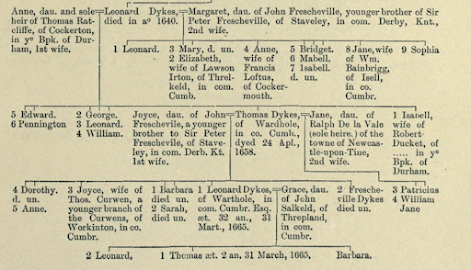Before the internet was invented, records were written; and before written records were kept (and you don't have to go back very far to get to a time when very few people could read and write, probably about 1850) family's kept memories alive with chats at the fireside. In 1852, Sir Bernard Burke published his records of "pedigrees": A visitation of the seats and arms of the noblemen and gentlemen of Great Britain and Ireland. Essentially, he travelled from stately home to stately home, meeting the families of repute who shared with him what written records they held, along with personal memories to establish their "pedigree". Families passed property and wealth from heir to heir, and the heir was usually the eldest surviving son of the current heir. If there was no son & heir to inherit, then the eldest daughter would pass on the family property and wealth to her husband. However, if the heir died "without issue" (having no children), then the estate would be up-for-grabs by whoever could prove to be the closest relation. Hence, visitation books were written to establish pedigrees of noble families and this one written by Sir Bernard Burke is one of the more reliable.
This extract (below) is taken from the book, and relates to the Dykes family, and their home and known history.
DYKES Of Dykesfield and Wardhall, and now of Dovenby, & Cumberland.
The name of Dykes, anciently Del Dykes, is derived from the Roman wall of Hadrian, in Cumberland. Dykesfield, where the family was anciently located, is situated directly upon the line of the wall. Mr. Bruce, in his " Roman Wall" ("Dykesfield"),considers the place " to derive its name from the works of the barrier, and to have been the site of a station." This no doubt is so (and the one circumstance only, of course, tallies with and goes to confirm the other), in as far as it is derived from the name of the family, which was itself, in the first instance, derived from the works of the barrier. The family would certainly take their name from, or give it to, the locality where they were seated, as it corresponds with their own. In the latter case they would have been De Dykesfield, but as Del Dykes instead, it is evident they, in the first instance, received the name from their occupation of the castellum, or station, on the barrier, and the adjoining locality, and gave it to the place. This is completely the tradition of the place, and Mr. Bruce since coincides in the same. [The Saxon appellation of "the Dyke" was given to the wall here, as to that of Lollius Urbicus (Grahams Dyke), and the Teutonic appellation of Dyke (Deich) was as appropriate for the wall as its Pelasgic congener rax(°c) would have been.]
Hence, del Dyke, but actually Del Dykes, as may be considered, in the plural number, the locality of Dykesfield being the precise termination of the one and so the junction of the two works (or " dykes" as then denominated), the vallum and murus, the former terminating at this point as it did at the corresponding one on the east, near Newcastle — the Pons iElii.
Kimber's Baronetage,"(vol.ii.p.408.) in its account of the Sussex and Kentish branches of this family , says : — "The family of Dyke, or Dykes, was seated at Dykesfield, in Cumberland, before the Norman conquest, but by several intermarriages removed their seat to Wardhall, in that county, of which was Leonard Dykes, Esquire, chief heir male. A branch of this family very early removed into Sussex, where they were seated at Henfield and other places, and one was seated at Cranbrook, in Kent, of which was Reginald de Dyke, Sheriff of Kent, 29th(c:1356) Edward III." The elder of these junior branches is represented by Sir Percyvall Hart Dyke, Bart., of Lullingstone ; another by Sir Thomas Dyke Acland, Bart., of Holincote and Killerton, and his son, Mr. Dyke Groyte, the arms borne being the same.
The first written records of the family in existence, and the pedigree recorded in the Heralds' College, commence about the time of Henry III. or Edward l. As Cumberland up to about the time of Henry III, was so much a part of Scotland, and the arms borne are of the ancient class in the College that are without date, it is possible there may have been previous records of the family in the heraldic archives of that kingdom, which unfortunately about the time of Charles I. were destroyed by fire.*
Robert del Dykes, in a deed without date, conveys lands at Burgh (close to Dykesfield and also on the line of the wall) to William del Monkys. The name of the Lord Hugh de Multon occurring in the deed fixes the date about the end of Henry III. or beginning of Edward I (c.1270-1273). The recorded pedigree in the Heralds' College commences at the same time with William del Dykes.
In a deed without date, supposed by the writing to be of the period of the reigns of Hen. III. and Ed. L, Symon de Crosseby, clerk of Carlisle, conveys lauds at Waverton to William del Dykes — witnesses, the Lord Richd. Benton, then sheriff; Henry de Malton, Knt., and others. He was father of William del Dykes, who, temp. Edw. II. (1326), m. Agnes or Agneta, heiress of Sir Hugh de Waverton, of Waverton, 5th (c:1332) of Edward III. is a conveyance of lands at Waverton to " John de Ormeby and Agnet del Dykes, and their heirs." To be continued...


